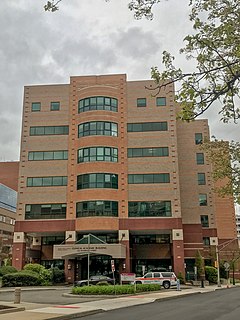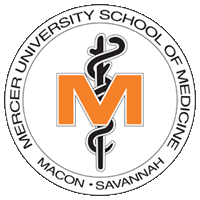Osteopathic medicine is a branch of the medical profession in the United States that promotes the practice of allopathic medicine with a set of philosophy and principles set by its earlier form, osteopathy. Osteopathic physicians (DOs) are licensed to practice medicine and surgery in all 50 US states. Only graduates of American osteopathic medical colleges may practice the full scope of medicine and surgery generally considered to be medicine by the general public; US DO graduates have historically applied for medical licensure in 87 countries outside of the United States, 85 of who provided them with full scope of medical and surgical practice. The field is distinct from osteopathic practices offered in nations outside of the U.S., whose practitioners are generally not considered part of core medical staff nor of medicine itself. The other major branch of medicine in the United States is referred to by practitioners of osteopathic medicine as allopathic medicine.
The Association of American Medical Colleges (AAMC) is a nonprofit organization based in Washington, D.C. that was established in 1876. It represents medical schools, teaching hospitals, and academic and scientific societies, while providing services to its member institutions that include data from medical, education, and health studies, as well as consulting. The AAMC administers the Medical College Admission Test and operates the American Medical College Application Service and the Electronic Residency Application Service. Along with the American Medical Association, the AAMC co-sponsors the Liaison Committee on Medical Education, the accrediting body for all U.S. MD-granting medical education programs.

Residency or postgraduate training is specifically a stage of graduate medical education. It refers to a qualified physician who practices medicine, usually in a hospital or clinic, under the direct or indirect supervision of a senior medical clinician registered in that specialty such as an attending physician or consultant. In many jurisdictions, successful completion of such training is a requirement in order to obtain an unrestricted license to practice medicine, and in particular a license to practice a chosen specialty. An individual engaged in such training may be referred to as a resident, registrar or trainee depending on the jurisdiction. Residency training may be followed by fellowship or sub-specialty training.
According to the US Department of Education, the Educational Commission for Foreign Medical Graduates is "the authorized credential evaluation and guidance agency for non-U.S. physicians and graduates of non-U.S. medical schools who seek to practice in the United States or apply for a U.S. medical residency program. It provides comprehensive information and resources on licensure, the U.S. Medical Licensure Examination (USMLE), residencies, and recognition."

Medical education is education related to the practice of being a medical practitioner, including the initial training to become a physician and additional training thereafter.

The American Osteopathic Association (AOA) is the representative member organization for the more than 145,000 osteopathic medical doctors (D.O.s) and osteopathic medical students in the United States. The AOA is headquartered in Chicago, Illinois, and is involved in post-graduate training for osteopathic physicians. Beginning in 2015, it began accrediting post-graduate education as a committee within ACGME, creating a unified accreditation system for all DOs and MDs in the United States. The organization promotes public health, encourages academic scientific research, serves as the primary certifying body for D.O.s overseeing 18 certifying boards, and is the accrediting agency for osteopathic medical schools through its Commission on Osteopathic College Accreditation. As of October 2015, the AOA no longer owns the Healthcare Facilities Accreditation Program (HFAP), which accredited hospitals and other health care facilities.

Rutgers Robert Wood Johnson Medical School is a medical school of Rutgers University. It is one of the two graduate medical schools of Rutgers Biomedical and Health Sciences, together with New Jersey Medical School, and is closely aligned with Robert Wood Johnson University Hospital, the medical school's principal affiliate.
Established in 1933, the American Board of Medical Specialties (ABMS) is a non-profit organization which represent 24 broad areas of specialty medicine. ABMS is the largest physician-led specialty certification organization in the United States.
The Liaison Committee on Medical Education (LCME) is an accrediting body for educational programs at schools of allopathic medicine in the United States and Canada. The LCME is sponsored by the Association of American Medical Colleges and the American Medical Association. It publishes many guides and standards, including the Directory of Accredited Medical Education Programs. The LCME currently accredits 155 U.S. schools, which includes 4 in Puerto Rico, as well as 17 others in Canada. The LCME accredits only the schools that grant a Doctor of Medicine (M.D.) degree. Osteopathic medical schools that grant the Doctor of Osteopathic Medicine (D.O.) degree are accredited by the Commission on Osteopathic College Accreditation of the American Osteopathic Association.
An international medical graduate (IMG), earlier known as a foreign medical graduate (FMG), is a physician who has graduated from a medical school outside of the country where he or she intends to practice. The term non-local medical graduate may be similarly used in countries with distinct licensing regions within them. Generally, the medical school of graduation is one listed in the World Directory of Medical Schools (WDOM) as accredited by the Foundation for Advancement of International Medical Education and Research or the World Health Organization.
Medical school in the United States is a graduate program with the purpose of educating physicians in the field of medicine. Such schools provide a major part of the medical education in the United States. Most medical schools in the US confer upon graduates a Doctor of Medicine (MD) degree, although some confer a Doctor of Osteopathic Medicine (DO) degree, and, unique to the United States, a few confer the Doctor of Podiatric Medicine (DPM) degree. Most schools follow a similar pattern of education, with two years of classroom and laboratory based education, followed by two years of clinical rotations in a teaching hospital where students see patients in a variety of specialties. After completion, graduates must complete a residency before becoming licensed to practice medicine.
Most physicians in the United States hold either the Doctor of Medicine degree (MD) or the Doctor of Osteopathic Medicine degree (DO). Institutions awarding the MD are accredited by the Liaison Committee on Medical Education (LCME). Institutions awarding the DO are accredited by the Commission on Osteopathic College Accreditation (COCA). The World Directory of Medical Schools lists both LCME accredited MD programs and COCA accredited DO programs as US medical schools. Foreign-trained osteopaths do not hold DO degrees and are not recognized as physicians in the United States or in other jurisdictions.
The University of Arizona College of Medicine – Tucson, located in Tucson, Arizona, is one of three MD granting medical schools in the state of Arizona, affiliated with the University of Arizona. The University of Arizona College of Medicine – Phoenix was initially established as a branch campus in 2007, but became an independent medical school in 2012. The College of Medicine – Tucson campus is located at the University of Arizona Health Sciences (UAHS) center on the campus of the University of Arizona and is governed by the Arizona Board of Regents. Traditionally, the college accepted Arizona residents exclusively. However, beginning the 2009–2010 incoming class, the school changed its policy to allow for admission of "highly-qualified," non-residents.

The UCLA International Medical Graduate (IMG) Program is a non-profit educational program for Hispanic International Medical Graduates who are residing in the US legally. Housed in the Dept of Family Medicine of the David Geffen School of Medicine at UCLA in Los Angeles, California the IMG Program was created to train immigrant physicians who could address the linguistic and cultural barriers to care faced by California's largely underserved Hispanic population.
The Federation of State Medical Boards (FSMB) of the United States is a national non-profit organization that represents the 71 state medical and osteopathic boards of the United States and its territories and co-sponsors the United States Medical Licensing Examination. Medical boards license physicians, investigate complaints, discipline those who violate the law, conduct physician evaluations, and facilitate the rehabilitation of physicians where appropriate. The FSMB's mission calls for "continual improvement in the quality, safety and integrity of health care through the development and promotion of high standards for physician licensure and practice."
The Joan C. Edwards School of Medicine is the medical school at Marshall University in Huntington, West Virginia. It is one of three medical schools in the state of West Virginia.
The Medical School Admission Requirements Guide (MSAR) is a suite of guides produced by the Association of American Medical Colleges (AAMC), which helps inform prospective medical students about medical school, the application process, and the undergraduate preparation. The MSAR staff works in collaboration with the admissions offices at each medical school and combined B.S./M.D. program to compile information about each school and program. This data originates from a number of sources including the:

Mercer University School of Medicine (MUSM) is the graduate medical school of Mercer University and a component of the Mercer University Health Sciences Center. It was founded in 1982 in Macon, Georgia, United States, and in 2008 opened a second campus in Savannah, Georgia with either site allowing students to complete all four requisite years of medical training. In 2012 MUSM developed a third site in Columbus, Georgia at which students may elect to complete their third and fourth years of training.

The Frank H. Netter M.D. School of Medicine at Quinnipiac University, also known colloquially as Quinnipiac Medical School, or simply "Netter," is a medical school located in North Haven, Connecticut. Established in 2010.
The antitrust class-action lawsuit Jung v. AAMC alleged collusion to prevent American trainee doctors from negotiating for better working conditions. The working conditions of medical residents often involved 80- to 100-hour workweeks. The suit had some early success, but failed when the U.S. Congress enacted a statute exempting matching programs from federal antitrust laws.






